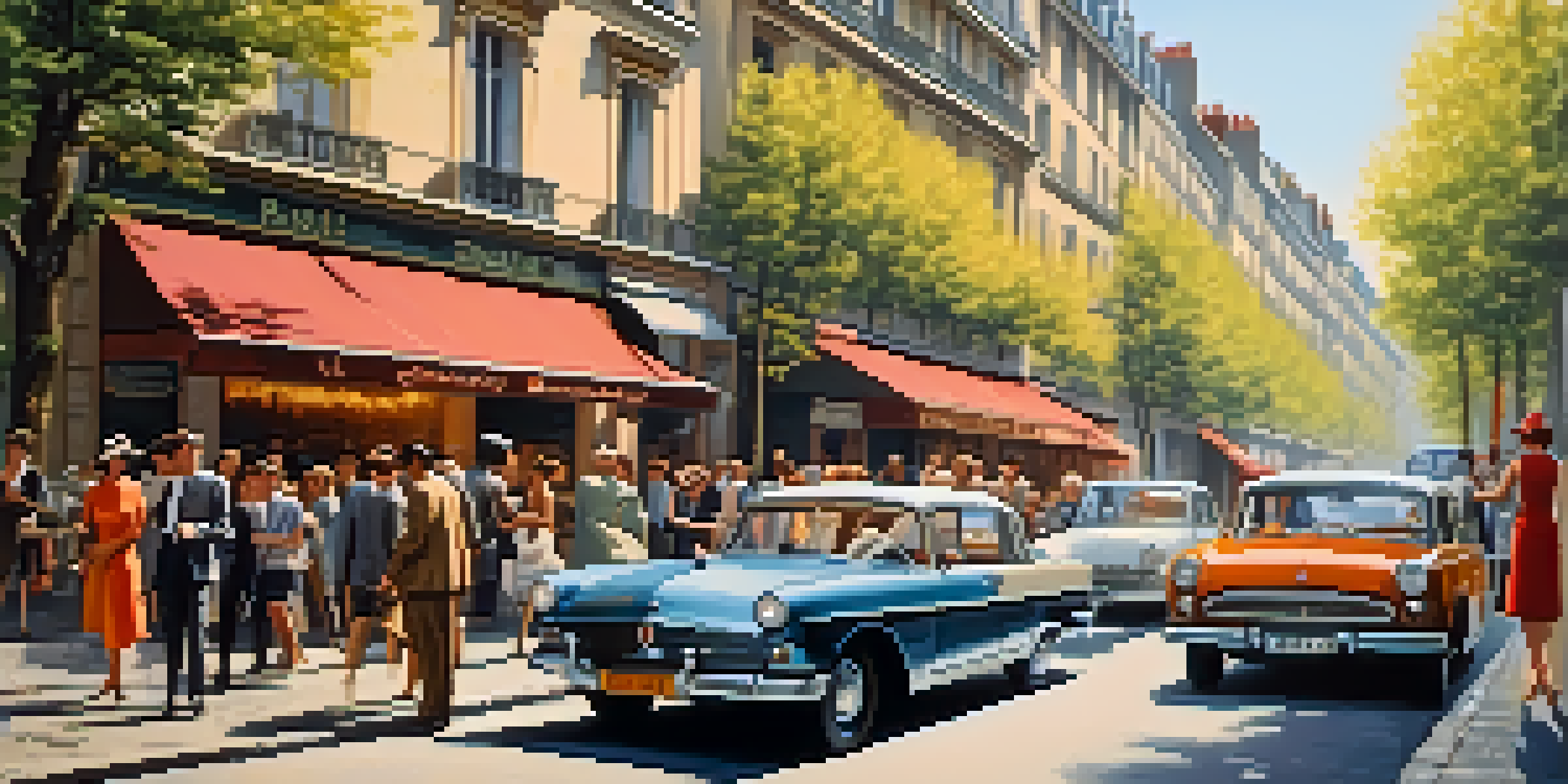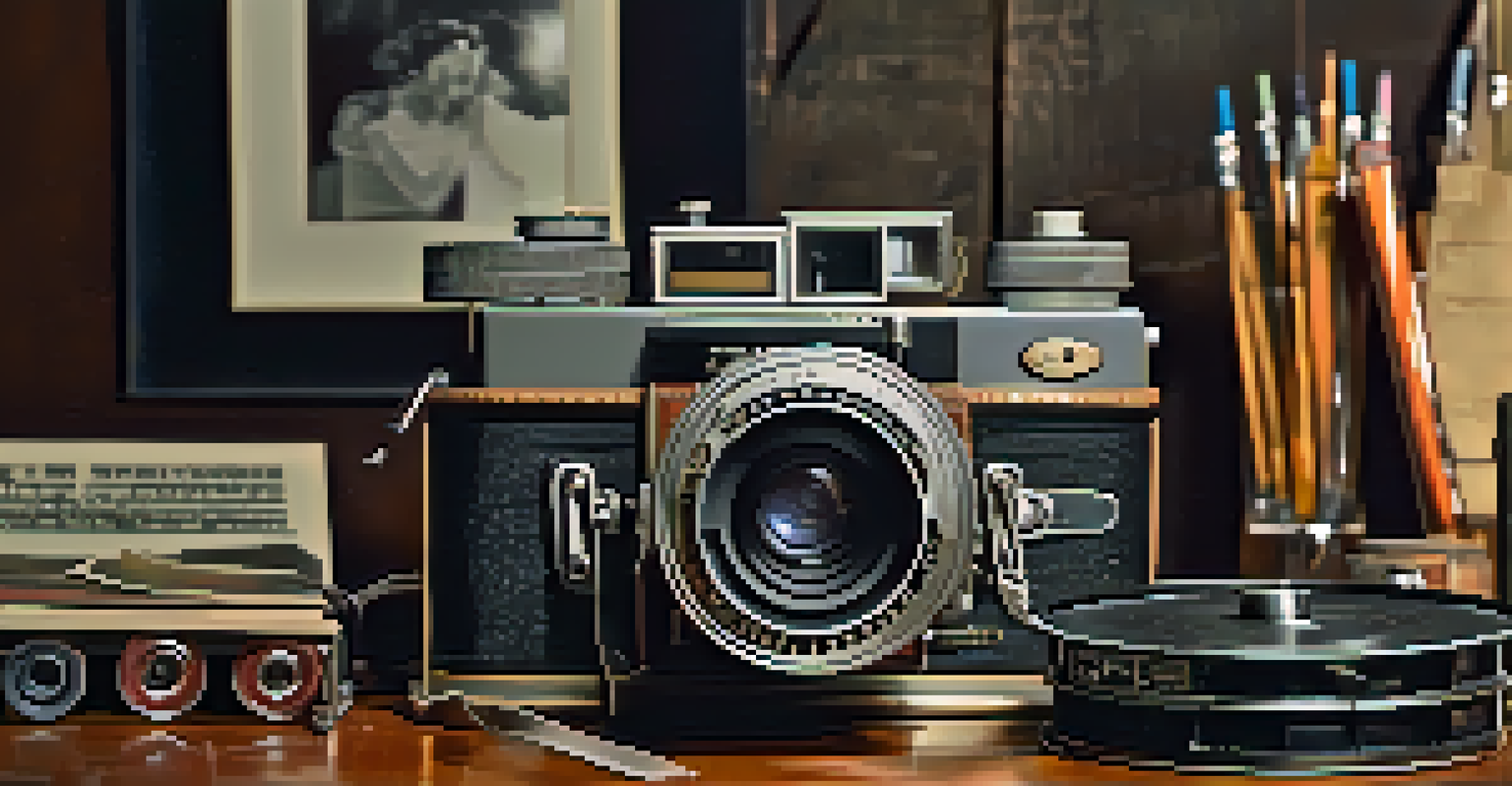French New Wave: Revolutionizing Cinema with Unique Narratives

Introduction to French New Wave and Its Origins
The French New Wave, or La Nouvelle Vague, emerged in the late 1950s and early 1960s, fundamentally altering how stories were told on screen. This movement began as a response to the rigid structures of traditional filmmaking, emphasizing personal expression and creativity. Directors like François Truffaut and Jean-Luc Godard sought to break free from conventional norms, paving the way for a fresh cinematic language.
The film is a very powerful medium for the expression of ideas, and the French New Wave demonstrated that cinema could be a personal and subjective experience.
The roots of the French New Wave can be traced back to a group of young critics at the magazine 'Cahiers du Cinéma,' who championed auteur theory. This theory posits that the director is the primary creative force behind a film, similar to a writer of a novel. These critics would later become filmmakers themselves, implementing their revolutionary ideas and perspectives into their works.
The movement was characterized by its innovative narrative techniques, such as nonlinear storytelling, spontaneous dialogue, and breaking the fourth wall. By embracing these stylistic choices, filmmakers effectively transformed cinema into a more intimate and experimental medium, inviting audiences to engage with films in unprecedented ways.
Key Characteristics of French New Wave Cinema
One of the defining features of French New Wave cinema is its departure from the polished, studio-centric productions of the past. Instead, filmmakers opted for location shooting and natural lighting, lending a sense of realism to their narratives. This approach not only reflected the spontaneity of life but also made the filmmaking process more accessible and relatable.

Another hallmark of this movement is the use of jump cuts, a technique that disrupts the continuity of time and space. By intentionally slicing scenes together in unexpected ways, directors created a sense of urgency and excitement that mirrored the frenetic pace of modern life. This stylistic choice challenged audiences to adapt and engage with the film actively.
Origins of French New Wave
The French New Wave emerged in the late 1950s as a response to traditional filmmaking, focusing on personal expression and innovative storytelling.
Moreover, French New Wave films often include self-referential elements, where characters acknowledge they are in a film or discuss the filmmaking process. This blurring of reality and fiction invites viewers to reflect on the nature of cinema itself, making them more aware of the artistic choices at play. These unique characteristics set the stage for a new era of storytelling in film.
Influential Directors of the French New Wave
François Truffaut is often considered a central figure of the French New Wave, with his film 'The 400 Blows' serving as a seminal work that encapsulated the movement's essence. The film follows a young boy's tumultuous life, exploring themes of adolescence and alienation in a raw and honest manner. Truffaut's ability to evoke deep emotions while employing unconventional storytelling techniques solidified his place in cinema history.
The New Wave was a way of making films that was based on a very personal vision, a very personal reaction to the world.
Jean-Luc Godard, another pivotal director, pushed the boundaries of narrative and visual style even further. His film 'Breathless' is a prime example, featuring a fragmented storyline and a non-linear approach that left traditional audiences bewildered yet captivated. Godard's bold experimentation with form and content encouraged future generations of filmmakers to think outside the box.
Agnès Varda, often called the grandmother of the New Wave, brought a unique feminine perspective to the movement. Her film 'Cléo from 5 to 7' intertwined real-time narrative with existential themes, showcasing the inner thoughts of a woman facing mortality. Varda’s work not only highlighted the experiences of women in film but also expanded the narrative possibilities of the medium.
Themes Explored in French New Wave Films
French New Wave films often dive into themes of existentialism and the search for identity. Characters frequently grapple with their place in the world, reflecting the societal changes occurring in France during the 1960s. This exploration of the human condition resonates with audiences, inviting them to contemplate their own lives through the lens of cinema.
Another recurring theme is the tension between love and freedom, as many films depict characters caught in complex relationships. These narratives often challenge traditional romantic ideals, illustrating how love can be both liberating and confining. By presenting love in a more nuanced light, filmmakers encouraged viewers to rethink their perspectives on relationships.
Key Characteristics of the Movement
Filmmakers utilized techniques like location shooting, jump cuts, and self-referential elements to create a more intimate and experimental cinematic experience.
Additionally, the impact of modernity and urban life is a prominent theme within this movement. Many films showcase the hustle and bustle of city living, juxtaposed with moments of introspection and solitude. This duality mirrors the dichotomy of contemporary existence, capturing the essence of life in a rapidly changing world.
The Impact of French New Wave on Global Cinema
The influence of the French New Wave extends far beyond its home country, shaping the landscape of global cinema. Filmmakers around the world began to adopt its principles, embracing experimental storytelling and pushing creative boundaries. This movement inspired new waves of cinema in countries like Japan, the United States, and beyond, leading to a richer, more diverse film culture.
Directors such as Martin Scorsese and Quentin Tarantino credit the French New Wave for impacting their own filmmaking styles. Scorsese's use of jump cuts and unconventional narratives, for example, can be traced back to the innovations of Godard and Truffaut. Similarly, Tarantino's dialogue-driven storytelling and self-referential humor echo the techniques established by New Wave filmmakers.
Moreover, the movement's emphasis on personal expression and authorial voice has encouraged countless filmmakers to tell their unique stories. By championing individuality and creativity, the French New Wave paved the way for a new generation of artists who continue to shape the film industry today.
Cinematic Techniques Unique to French New Wave
French New Wave directors employed various groundbreaking cinematic techniques that set their films apart from traditional works. One such technique is the use of handheld cameras, which allowed for greater mobility and spontaneity during shooting. This choice created a more intimate connection between the audience and the characters, as if viewers were experiencing the story alongside them.
Additionally, the incorporation of direct sound recording was a significant shift from the norm. By capturing dialogue on location rather than in a studio, filmmakers enhanced the authenticity of their narratives. This approach not only added realism but also fostered a sense of immediacy, drawing audiences deeper into the cinematic experience.
Global Influence of French New Wave
The movement significantly impacted global cinema, inspiring filmmakers worldwide to adopt its experimental styles and emphasis on personal storytelling.
Finally, the playful use of editing, particularly the jump cut, became a signature element of the French New Wave. This technique disrupted the flow of time, creating a rhythmic energy that captivated viewers. By challenging traditional editing conventions, directors encouraged audiences to engage with the film in new and unexpected ways.
Legacy of the French New Wave Today
The legacy of the French New Wave continues to resonate in contemporary cinema, as filmmakers draw inspiration from its innovative narrative styles and thematic explorations. Many modern directors incorporate elements of the movement into their work, whether through nonlinear storytelling or self-referential humor. This ongoing influence serves as a testament to the movement's lasting impact on the film industry.
Film schools around the world often analyze French New Wave films as essential case studies for aspiring filmmakers. By studying these works, students gain insights into the creative process and the importance of personal vision in storytelling. The movement not only transformed cinema in its time but also provided a foundation for future generations to build upon.

In essence, the French New Wave revolutionized how stories are told on screen, inspiring artists to embrace their individuality and challenge conventions. As audiences continue to seek fresh narratives and authentic voices, the spirit of the French New Wave lives on, reminding us of the power of cinema to provoke thought and evoke emotion.